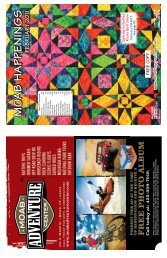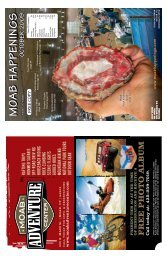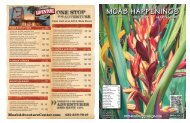Moab Happenings ⢠August 2010
Moab Happenings ⢠August 2010
Moab Happenings ⢠August 2010
Create successful ePaper yourself
Turn your PDF publications into a flip-book with our unique Google optimized e-Paper software.
www.moabhappenings.com<br />
Canine Obesity – A Big Fat Problem<br />
by Kaye Davis of <strong>Moab</strong> BARKery<br />
Canine obesity is an important - and very common<br />
- medical condition with serious health implications. The<br />
American Veterinary Medical Association (AVMA) has<br />
estimated that there are 41 million pet dogs in the United<br />
States and some sources suggest that 40%, approximately<br />
17 million, of these dogs are overweight or obese. It’s easy<br />
to tell when you have added a few<br />
pounds, that favorite pair of jeans gets<br />
a little too snug; unfortunately, it is<br />
not as obvious with your dog. Most<br />
owners do not even know when their<br />
dogs are overweight.<br />
According to the AVMA only<br />
17% of owners believe their dogs<br />
have a weight problem, whereas vets<br />
reported that 47% of their client’s<br />
dogs are overweight. The reason for<br />
the distortion could be that since<br />
almost half of all dogs are overweight or obese, fat dogs<br />
are beginning to look more like the rule than the exception.<br />
Heavy dogs are becoming the “norm,” making dogs at a<br />
healthy weight appear under nourished.<br />
You can tell that your dog is overweight or obese if<br />
cannot feel their ribs or spine beneath their fat deposits,<br />
their fat deposits extend to the chest or tail and hindquarters.<br />
An obese dog will also have a waist that is distended or<br />
pear shape when viewed from above and an abdomen that<br />
sags when viewed from the side. Common health problems<br />
that occur in overweight and obese dogs are diabetes, joint<br />
problems, osteoarthritis, respiratory disorders, high blood<br />
pressure, heart disease, kidney and liver problems and<br />
cancer. If you are not sure if your dog is overweight or not<br />
you should consult your vet.<br />
What is causing this obesity epidemic in our canine<br />
companions? The biggest contributor is that the majority<br />
of commercially available food produced by the pet food<br />
industry is made with no regard to<br />
the biological needs of your dog.<br />
While it is true that more holistic and<br />
biologically appropriate dog foods<br />
are available today, the reality is that<br />
these barely represent 10 percent of<br />
what is available on the market. The<br />
companies making these foods are<br />
the small players in the market.<br />
The large companies that<br />
represent the other 90 percent of<br />
dog food sold in this country are not<br />
interested or motivated in creating<br />
nutritiously sound food for your dog;<br />
they are interested in developing marketable and profitable<br />
products. What that means for you as a consumer is that<br />
90 percent of foods available commercially contain<br />
ingredients that are highly inappropriate for your dog but<br />
are also loaded with salt, sugar and fat.<br />
Most owners that know that their dog is overweight<br />
or obese want to do something about it but many owners<br />
are getting bad advice about how to slim down their portly<br />
pets! Most people think that it is as easy as feeding their<br />
dog a low fat or diet formula and the pounds will drop<br />
off. However, the formulation of low fat and diet formulas<br />
available for dogs are NOT based on their biological or<br />
nutritional needs and this is why diet or low fat formulas<br />
can actually cause weight gain.<br />
The first thing fat dog owners need to understand is that<br />
“low fat” food is “high carbohydrate” food. Carbohydrates<br />
added to commercial pet foods include corn, wheat, soy,<br />
rice, potato and oatmeal. Although these starches are low in<br />
fat they are high in calories and unless these extra calories<br />
are burned away through exercise it will be deposited as<br />
fat. Adding excessive amounts of carbohydrates to diet<br />
PET HAPPENINGS<br />
foods also means that other vital nutrients are displaced,<br />
the main one being protein. Most low fat diets are 80<br />
percent carbohydrates and 20 percent protein; some of the<br />
worst offenders are 90 percent carbohydrates.<br />
Ten or even 20 percent protein is not enough for your<br />
carnivorous dog. Carnivores are designed by nature with<br />
a high protein requirement, as it is<br />
the essential fuel that is required by<br />
your dog. When your dog is protein<br />
deprived eventually they will develop<br />
symptoms of a serious nutritional<br />
deficiency which manifest in an<br />
increase in weight, flaky skin and<br />
nails, poor muscle tone and dry, dull<br />
and brittle coat with patchy hair loss.<br />
Diet foods also contain a high<br />
level of fiber as well; the idea behind<br />
this being that it will make your dog<br />
feel full. However, what it really does is cause your dog<br />
to poop excessively whilst blocking the absorption of<br />
healthy nutrients in the small intestine. Fiber may make<br />
your dog feel temporarily full but in reality all it is doing<br />
is creating chronic deprivation of nutrients at the cellular<br />
level, constant hunger and protein deficiency. Next to<br />
water, protein is the most important nutrient required by<br />
your carnivorous dog and when their cells are deprived of<br />
it a host of negative side effects can occur.<br />
So how do you help your fat dog? The best way to<br />
keep your pet healthy is to prevent them from getting fat in<br />
the first place. However if you already have a porky pooch,<br />
here are some tips for helping them slim down…<br />
Practice Portion Control - Remember that regardless<br />
of their weight, your dog still needs a diet high in protein.<br />
Feed your dog a high protein, low carbohydrate diet and<br />
moderate the portions to control the amount of calories they<br />
are consuming. Obviously, you can’t serve an all-day, allyou-can-eat<br />
buffet to an overweight<br />
pet so have scheduled feeding times<br />
in the morning and evening.<br />
Exercise With Your Dog -<br />
An overweight body slims down<br />
by moving more and eating less.<br />
So along with calorie restriction<br />
through portion control, it’s also<br />
really important that you set up a<br />
good exercise program for your dog.<br />
Daily aerobic activity is one of the<br />
best ways to build muscle tone, and<br />
muscle tone decreases the amount<br />
of fat that your dog carries around.<br />
Muscle mass also increases metabolism, which helps burn<br />
calories and not just the dog’s calories.<br />
Minimize The Treats - You can still give your dog<br />
treats, but make them protein-based and feed very small<br />
amounts at scheduled times throughout the day. Make<br />
sure to include the calories in treats as part of your portion<br />
control plan.<br />
There’s not a single more important step you can take<br />
for your pet’s longevity and quality of life than to help your<br />
best furry friend achieve and maintain a healthy weight.<br />
Humane Society of <strong>Moab</strong> Valley<br />
Special Events<br />
<strong>August</strong> 21 Dog Days of Summer<br />
Annual Bar-B-Q and Silent Auction Benefit -<br />
Buck’s Grillhouse 4:30-9:00pm<br />
<strong>August</strong> 22 Beat the Heat River Trip<br />
call 259-4862 (see page 5)<br />
<strong>Moab</strong> <strong>Happenings</strong> • <strong>August</strong> <strong>2010</strong> • 15B<br />
Humane Society of <strong>Moab</strong> Valley<br />
<strong>August</strong> Events<br />
<strong>August</strong> 7 & 21 Cat & Kitten Adoptions<br />
10am-12pm at the <strong>Moab</strong> BARKery. All ages and<br />
personalities, all sizes and colors. Whether you’re<br />
looking for handsome gray fur-ball or a little guy<br />
looking dapper in a tuxedo, we’ve got the feline<br />
friend for you.<br />
<strong>August</strong> 14 & 28 Dog & Puppy Adoptions<br />
10am-12pm at City Market. We have some<br />
amazing dogs waiting for their forever homes,<br />
including a Husky mix and a friendly girl found<br />
wandering Capital Reef.<br />
Come meet your new best friend!. Pictures and<br />
info in The Ad-vertiser and www.moabpets.org.<br />
Call 259-4862 to set up a meet-and-greet if you<br />
can’t make it to Adoption Days.<br />
<br />
<br />
<br />
<br />
<br />
<br />
<br />
<br />
4890 Sunny Acres Lane, <strong>Moab</strong> 435-259-4841<br />
<br />
NOW OPEN<br />
<br />
<br />
<br />
<br />
<br />
<br />
Located inside the <strong>Moab</strong> BARKery<br />
82 N. Main<br />
Monday – Saturday<br />
Call for an appointment<br />
New Local Phone Number 260-2949<br />
<br />
<br />
<br />
<br />
<br />
<br />
This page sponsored by:<br />
<br />
<br />
<br />
<br />
<br />
Providing quality nutrition, gear, treats and toys for your dog or cat.<br />
Fullfilling your pet Mind, Body & Spirit!<br />
Open at 10 AM everyday • 82 N. Main<br />
435-259-8080 • www.moabbarkery.com








